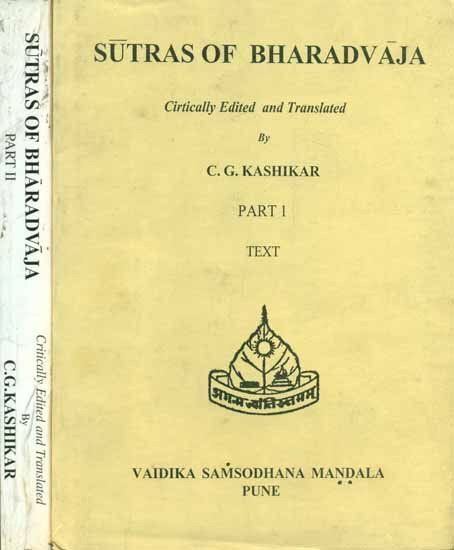Bharadvaja-srauta-sutra
by C. G. Kashikar | 1964 | 166,530 words
The English translation of the Bharadvaja-Srauta-Sutra, representing some of the oldest texts on Hindu rituals and rites of passages, dating to at least the 1st millennium BCE. The term Srautasutra refers to a class of Sanskrit Sutra literature dealing with ceremonies based on the Brahmana divisions of the Veda (Sruti). They include Vedic rituals r...
Praśna 10, Kaṇḍikā 4
1. According to some teachers, he should bathe in a tank.
2. He should put a piece of gold in a lake characterized by conch-shells, and bathe in it with the verse, “May the waters, the mothers, cleanse us; may those who purify the clarified butter, purify us with clarified butter; may they wash out of us the pollution;”[1] and with the formula, “I come out of these, clean and purified,”[1] he should come out of the water after he has bathed.[2]
3. He should sip water, and wear a new linen garment with the formula, “Thou art the body of Soma; do thou guard my body.”[3]
4. He should tie up the hem (of the garment) with the formula, “Thou art the hem of Soma.”[4]
5. With the formula, “Thou art vigour; do thou grant me vigour,”[5] he should partake of the food which he likes.
6. He should consume food mixed with ghee, and adding to it curds and honey.
7. Henceforward he is required to consume less quantity of food.
8. With the formula, “Thou art the milk of big (cows),”[6] he should take up butter by means of two clusters of darbha-blades, and with the formula, “Thou art the giver of splendour; place splendour in me,”1 he should anoint himself downwards three times.
9. He should first anoint his face and then other limbs downwards.
10. He should be well anointed.
11. He should then apply to his eyes the collynum procured from the Trikakud mountain.
12. If he cannot procure collyrium from the Trikakud mountain, he may apply any other collyrium.
13. With the formula, “Thou art the pupil of Vṛtra; thou art the guardian of the eye; do thou guard my eye,”[7] he should apply collyrium first to the southern eye with a blade of śara grass or a darbha-blade together with a panicle or a cluster of darbha-blades without moving the blade in a reverse direction. Three times to the southern eye, and two times to the northern one.[8]
Footnotes and references:
[1]:
Taittirīya-saṃhitā I.2.1.1.
[2]:
Āpastamba-śrauta-sūtra X.6.3 adds that the sacrificer’s wife also should do the same excepting the shaving of hair.
[3]:
Taittirīya-saṃhitā I.2.1.1.
[4]:
Vājasaneyi-saṃhitā IV.10.
[5]:
Taittirīya-saṃhitā I.8.15.2.
[6]:
Taittirīya-saṃhitā I.2.1.1.
[7]:
Taittirīya-saṃhitā I.2.1.2.
